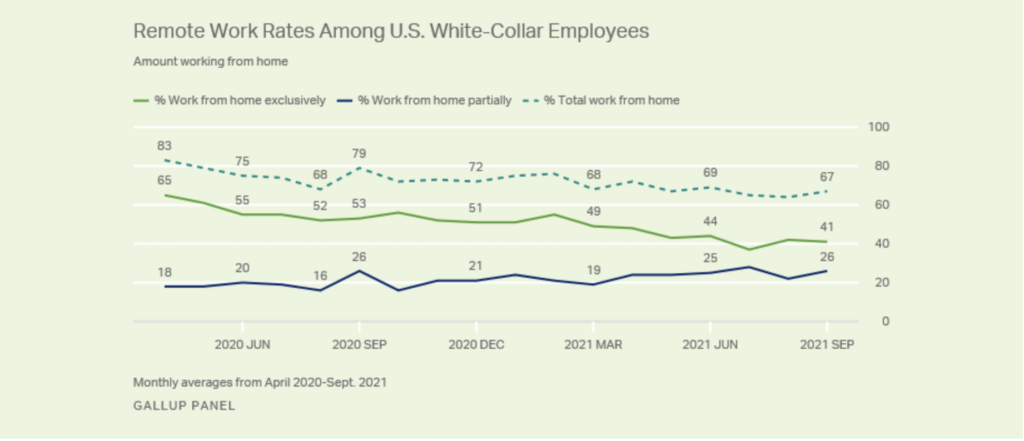Few companies are adopting a full return to the pre-pandemic normal. Instead, most of today’s work models incorporate hybrid and remote work.
Interest in “agile workplace” strategies has skyrocketed, as Fast Company reports. Instead of having a designated office, many employees can easily work from anywhere. Gallup found that 41% of white-collar employees work from home full-time. And 26% work remotely part of the time.
Nine of ten remote employees want to keep working remotely—to some extent. Just 9% want to return to the office full-time, while more than half prefer a hybrid model, says Gallup. Much of the support for remote work stems from the convenience factor. In a nutshell, employees who don’t commute have more time for things that matter.
Going fully remote or fully returning to normal brings challenges. Most companies are, therefore, adopting a combination of the two. Every organization must find its own balance and consider its own team’s preferences.
We have identified five major work models that companies are using today. How does performance management vary between them? Read on to find out.
Navigation
1. Office-Centred Hybrid Work Models
2. Combination Hybrid Work Models

1. Office-Centred Hybrid Work Models
In office-centred hybrid work models, employees work in the office most of the time. Still, they may have the option to work from home one or two days per week. Many companies feel this model enhances employees’ sense of belonging to a team, as Inc. says.
- Pros: Seeing each other face to face can create a strong culture and connections.
- Cons: Inconvenience to employees, expense of office space for a full staff.
Best practices:
Allow for flexible schedules even when employees come to the office. Flexible organizations are three times more likely to experience higher performance. Have an open dialogue about employees’ needs and concerns, too.
Case study:
Private real estate firm Harrison Street brought its employees back to the office in Fall 2021. Its leaders feel this decision will particularly benefit newer employees’ growth. “Being in the office makes sense,” says CEO Chris Merrill. “It’s very, very important for the younger people to be together. This is where they learn. It is where they grow. That is where you’re going to create upward mobility.”
2. Combination Hybrid Work Models
In some workplaces, certain employees must come to the office to fulfill their roles. For example, they may have direct interaction with customers. Meanwhile, others with behind-the-scenes roles might work remotely.
- Pros: Creating a tailored experience for each role. Companies may also be able to reduce their office space with this model.
- Cons: Can foster inequality. In-office employees may receive preference for opportunities. And remote employees may feel disconnected from the in-office team.
Best practices:
Cater to those who are working remotely during in-person meetings. A virtual-first mindset will help ensure no one gets left behind. A well-positioned camera and quality audio equipment are a must.
Additionally, don’t fall into the trap of micromanaging employees through tracking technology. This signals mistrust and erodes workplace culture. Focus on results rather than the exact process employees follow to achieve them. Talk with them regularly about their progress toward their goals and OKRs. Then, provide direction as needed. Use performance management software to track employees’ progress. And record employees’ successes by keeping a regular log of achievements.
Case study:
CitiBank Group’s model provides a good example of combination hybrid work models. Some employees must work at their bank branch on most days. Meanwhile, others can work from anywhere. And many have a hybrid schedule, coming to the office three days a week, explains the Digital Workplace.
Similarly, Google requires employees to come to the office three days per week. It’s also adopting innovative meeting formats. Campfire, a meeting concept with a circular format, includes vertical displays featuring the faces of virtual participants. This gives them a prominent seat at the table in any group setting.
3. Clubhouse Work Models

In the clubhouse model, employees come to the office to collaborate or socialize. The rest of the time, they typically work from home. Not everyone is in the office at one time. This model often involves hot-desking, or hoteling. This means employees may not have an assigned desk. Instead, they reserve an available space for their in-office time.
- Pros: Uses office space—and commuting time—strategically. Enhances comradery and idea-sharing.
- Cons: Managers may struggle to track performance when they only see employees sporadically. And employees have vastly different preferences for working hours, notes Gallup.
Best practices:
Establish designated meeting times for each team that usually work for everyone. Then, scheduling a meeting—and booking the space—will take less legwork. Also, design opportunities for regular brainstorming and idea-sharing. As Gartner explains, many organizations fear such interactions will dwindle when people don’t regularly cross paths. But by intentionally making space for them, you’ll promote innovative thinking.
“Progressive organizations are relying less on innovation by chance and more on innovation by design. Among employees whose organizations have high levels of intentional collaboration, 75% also report having high levels of team innovation,” says Gartner HR director Alexia Cambon.
Case study:
Ford allows employees to work from home as much as they like. However, beginning in 2022, they’ll come to the office for meetings and collaboration. (A full 95% desired this change, says OC Tanner.) The company has redesigned its facilities with a focus on group spaces.
4. Hub and Spoke Models
In this model, employees work from satellite offices instead of coming to a central location. These satellite offices are typically smaller and closer to where they live. These decentralized work models can reduce the risk of disruption.
- Pros: A strong team culture can form locally. Managers may become more attuned to employees’ strengths and weaknesses.
- Cons: The team could experience a sense of separation from the rest of the company. Teams might be prone to staying in their own silos as a result.
Best practices:
Stay connected with the rest of the company through periodic Zoom meetings. If possible, hold an occasional in-person meeting on an important topic. Hold in-person social events when feasible. For example, meet up to celebrate a major success.
Case study:
Target is closing its large central location in downtown Minneapolis. It will be distributing employees to locations in different parts of the region, explains the Digital Workplace. Almost 3,500 employees who had worked in its central office will now have a different “home base.” And Target is far from the only thriving hub-and-spoke model. REI sold its new headquarters to open smaller offices throughout the region. Company leaders love that this move also shrinks their carbon footprint!
5. Fully Remote Work Models

Employees work from home (or anywhere) full-time in this model. This allows the company to operate with no physical office. Although this model became more common during the pandemic, it’s not new. Some companies have been using a virtual-first (or strictly virtual) model for many years.
- Pros: High level of convenience, lower business expenses. Permits access to talent worldwide rather than being limited to one geographic area.
- Cons: Employees may miss the camaraderie of a physical office space. However, leaders can organize periodic meetups to enhance the social aspect of work. Also, managers may experience a learning curve in terms of leading remote teams.
Best practices:
Communicate more often with employees than you think you need to. In fact, err on the side of over-communicating. Check in with each member of your team every day. Give them specific feedback on things you’ve noticed that day or week.
Additionally, know that working remotely does not mean being isolated. Even without central offices, employees in the same area might occasionally meet up.
Similarly, employees can meet up virtually in synchronous work sessions. In these sessions, they can work independently but exchange ideas that arise. They can stay connected via Zoom or another platform through the work session.
Case study:
The company Codility, which helps engineering companies recruit talent, has gone fully remote. They’ve encouraged employees to move wherever their heart desires. However, they give employees access to WeWork sites. This allows them to go to a local coworking site whenever they like. If they work in the same area as other employees, they can meet up there together.
“In the cities where we have a high concentration of people, 30% of staff would come to the office each week (but not each day), and the rest occasionally for workshops and get-togethers,” says their CEO Natalia Panowicz in a BBC interview.
Want to learn more about how software can support performance management? Request a demo of our performance management system for a detailed overview. Whichever model you use, it will equip you for success.





